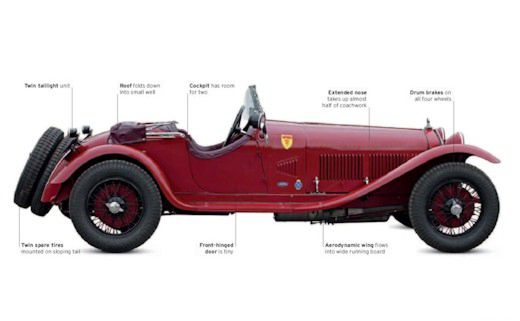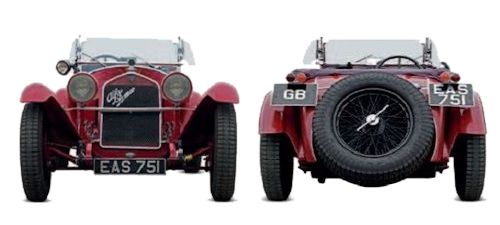Alfa Romeo 6C 1750 (1929-33)
One of the finest models ever produced by Alfa Romeo, the 6C 1750 is often considered to be the first true Grand Tourer. Equally at home on the road and the racetrack, the 6C was supplied as a rolling chassis upon which specialists ranging from British company James Young to the Italian Zagato studio would construct the bodywork.

It was a winning combination, with supercharged versions trouncing the opposition from 1929 to 1931 and providing Alfa Romeo with its first major crossover hit. Hiring Designer Vittorio Jano from Fiat in 1923 paid immediate dividends for Alfa Romeo. It was his genius that resulted in the awesome Alfa P2 winning the first ever Grand Prix World Championship in 1925.
In the same year he took elements of the racing model to develop the 6C 1500. Jano united a light frame with a small but high-revving power plant to create an exceptionally nimble car. Four years later, the six-cylinder engine was enlarged, resulting in the 6C 1750 that was unveiled at the Rome Motor Show.
- Model Alfa Romeo 6C 1750 (1929-33)
- Assembly Milan, Italy
- Production 2,579
- Construction Aluminium body on ladder frame
- Engine 1,752 cc, straight-six
- Power 46-102 bhp at 4,000-4,600 rpm
- Transmission Four-speed manual
- Suspension Live axle, semi-elliptic leaf springs
- Brakes Drums front and rear
- Maximum speed 68-106 mph (110-170 km/h)

As with the original 6C, a selection of specialist coachbuilders clothed the chassis, with Zagato creating some of the most popular designs. In addition to standard Turismo and Gran Turismo versions, Super Sport and Gran Sport variants were offered with ultra-reliable, supercharged engines that made them ideal for endurance racing. Victories at the 1929 and 1930 Mille Miglia events in Italy cemented the legacy of the 6C 1750 as a classic Alfa racer. Larger-engined 6Cs took up the mantle and continued the marque’s illustrious competition success well into the 1930s.

As with the original 6C, a selection of specialist coachbuilders clothed the chassis, with Zagato creating some of the most popular designs. In addition to standard Turismo and Gran Turismo versions, Super Sport and Gran Sport variants were offered with ultra-reliable, supercharged engines that made them ideal for endurance racing. Victories at the 1929 and 1930 Mille Miglia events in Italy cemented the legacy of the 6C 1750 as a classic Alfa racer. Larger-engined 6Cs took up the mantle and continued the marque’s illustrious competition success well into the 1930s.

Statement of intent
With its large grille to allow air in to help cool the smooth six-pot engine, huge headlights mounted on a chrome brace, and a small windshield to reduce aerodynamic drag, the 6C looked as though it meant business. The all-new, low-slung chassis in the preceding 1500 model was so sublime that it remained virtually unchanged on this larger 1750 variant.
Combined effort
First used in 1920, the Alfa Romeo name was a combination of the original ALFA (Anonima Lombarda Fabbrica Automobili) company with the surname of industrialist Nicola Romeo, who was a director of the fledgling marque from 1915 to 1928.
Alfa Romeo 6C exterior
Weight-saving and aerodynamics were specialities of Zagato. The Milan-based coachbuilder used aluminum over the rigid ladder chassis-slightly shortened on competition cars-to craft light but strong racing versions of the 6C 1750. Most of the examples were painted racing red or scarlet as pictured here-though some buyers chose a less-flattering white. Black wire-spoked wheels were standard.
Under the hood Alfa Romeo 6C
Base models featured a single-overhead-cam arrangement on the straight-six, while more performance-oriented variants incorporated a double-overhead-cam setup. A few pure race-bred competition cars were given a fixed-head (Testa Fissa) block. When combined with larger valves, a higher compression ratio, and a supercharger working flat out, it enabled a power output of 100 bhp or above.
Alfa Romeo 6C interior
The 6C’s spartan interior reflected its underlying character as essentially a race model. An array of dials and switches kept the driver up to date on what was happening under the hood. Leather and wood were used by some coachbuilders to outfit the small cockpit, but luxuries were kept to a minimum-even the small windshield and side windows provided negligible protection from the elements.